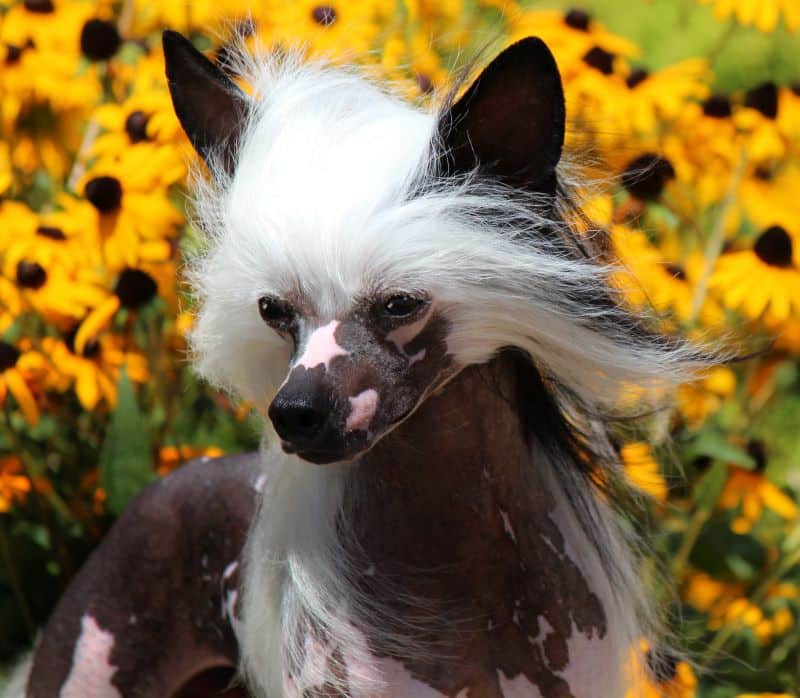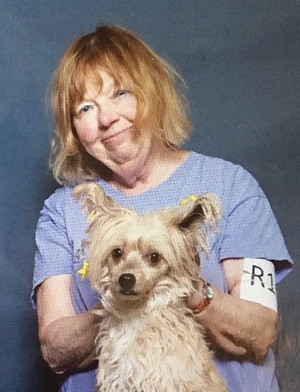


Home » Judging The Chinese Crested Breed

The Chinese Crested is a unique breed that comes in two distinct varieties; the Hairless, and the Powderpuff. When judging the Chinese Crested breed, judges should remember that both varieties are judged by the identical standard except for differences in teeth and coat, which I will cover later. Please do not forgive or ignore faults in one variety that you would not in
the other.
Both varieties should be given equal consideration. Please do not put an inferior Hairless dog up over a better Powderpuff. Unfortunately, Powderpuffs do not seem to get the recognition in the Breed and Group judging that the Hairless dogs do. So many Toy dogs in the Group are heavily coated, and the Hairless Crested stands out more than the Powderpuff does. Please do not overlook either variety!
The Chinese Crested may be free-baited or stacked in the ring. There is no preference for either presentation. Judges who insist on handlers free-baiting their dogs are not being fair to the handler or dog. And please move the dog around the ring before putting it up on the table, even if it is a single class entry. This shakes the kinks out of the dog (and handler), and on a cold morning or in a cold building it warms the Hairless up a bit, so it doesn’t shake as much on the table.
Our current AKC standard is what we must judge by. There is an alarming tendency for people to misquote the standard in ads and articles, or leave out words that change the meaning of the standard. It is always a good idea to review the standard before a
judging assignment.
The Chinese Crested varieties are identical in outward appearance—except for coat. The breed should be fine-boned, elegant, and graceful. It is one of the bigger Toy breeds, 11-13″ tall. You will find smaller and bigger ones. The standard states that “slightly” larger or smaller dogs may be given full consideration. As a judge, you will have to determine what your interpretation of “slightly” is. Keep in mind that extremely small dogs will probably not have the correct movement, and extremely large dogs will probably lack good breed type. However, please do not judge on the principle of “the smaller the better.” A larger, heavier dog with a level topline, good structure, and good movement should beat a smaller dog that hackneys or has a bad topline.
Many people seem to have a problem with interpreting the wording of the standard. It states: “Rectangular… Body length from withers to base of tail is slightly longer than the height at the withers.” Besides the fact that the word “rectangular” is specifically stated in the standard, reading and understanding the next sentence will make it even clearer. When you say that the body length is “slightly longer” from the withers to the base of tail, this means that the length is even longer from the front of the chest to the base of the tail. It is not off-square, it is rectangular. This body type allows for the reach and drive of the correctly moving Chinese Crested.
Heads vary greatly in the breed, ranging from a more Chihuahua-type head with a shorter muzzle to a more Poodle-type head. Somewhere in the middle is correct. The muzzle and skull are balanced, and the head is wedge-shaped.
Eyes should be almond-shaped, and this is a problem in the breed. There are many round eyes and small eyes. Be sure, when examining the dog, that you check under the crest for correct eye shape. Eye color varies. Dark-colored dogs have dark-colored eyes, and lighter-colored dogs MAY have lighter-colored eyes. Remember, the “may” when you find white or cream dogs with black eyes. Some light-colored Hairless dogs have very pale eyes. Blue eyes are not specifically mentioned in our standard, and you will find them on occasion. This may be addressed in a future standard, but for now, as a judge, you will have to consider them in terms of the other merits of the dog.
Ears should be large. Small ears are a problem in the breed, and when set too high on the head, they change the expression of the breed. The hair on the ears may be trimmed (shaved) in either variety, and heavy furnishings on the ears may cause them to look as if they are not erect.
Nose color also varies with the color of the dogs; while dark dogs should have dark noses, lighter-colored dogs MAY have lighter noses.
This is one of the two major differences between the varieties. While the Powderpuff must have full dentition, the Hairless is not to be faulted for missing teeth. While not mentioned in the standard, many Hairless dogs’ teeth may “tusk,” meaning that the teeth, both upper and lower, incline slightly forward (rather than straight up and down) while still retaining a scissors or level bite. Undershot bites are a problem in the breed and, while not specifically mentioned as a fault, will weigh in your final decisions.
In the process of judging the Chinese Crested his topline is often hard to judge. A cold and or nervous Hairless will make himself look terrible, and the coat on a Powderpuff will often destroy its topline on the move. The Powderpuff may be shown with its coat evenly parted down the middle or casually tousled; either is correct. Check toplines carefully on the table. A Hairless may be carefully stacked to give the appearance of a level topline, but movement will show the true picture. On the other hand, the Powderpuff may have a great topline, but the hair on its rear will “puff up” when moving, and make it look high in the rear—when it isn’t. Check toplines carefully. They are a major problem in the breed.
When judging the Chinese Crested, the standard does not call for a “gay” tail! It states that the tail is “carried gaily,” which is a big difference. It also says that the tail “may be carried slightly forward over the back,” not that it has to! See what omitting or changing words does to interpreting a standard?
The original American standard and the standards of some other organizations call for a tail that is carried “up or out” in motion. Since most Cresteds don’t read, they still carry their tails that way. I still remember a judge withholding ribbons from three beautiful puppies at a show several years ago when they did not have their tails up in the air, but rather out behind them while moving.
This still is a tail carried “gaily” and should not be faulted. The tail does not have to go over the back, and if it does, it is only carried “slightly” forward over the back. It should not curl over and touch the back. Handlers that push the tail over on the back while stacking the dog (more often done with Powderpuffs) are doing a real disservice to the breed, and are ruining the rectangular look of the breed. The Crested used to be shown with the tail curled around the left hock; many handlers still do, and it is a presentation unique to our breed.
The feet on a Crested should be narrow; a true “hare” foot, with elongated toes. Many Crested use their feet to actually pick up small objects.
Here is the only other difference between the two varieties. The Hairless ranges from what many call a “true” Hairless, with very little crest, socks or tail plume, to dogs dripping with furnishings. With that extreme amount of furnishings often comes body hair, which is removed for the show ring. A judge is not there to try to determine whether a dog has had hair removed or not; most have to some extent. Judging the Chinese Crested on the quality of the skin, which should be soft and smooth. There are some handlers who let the hair on the neck grow down over the withers. This goes against the standard, which states that the hair on the crest tapers off between the base of the skull and the back of the neck. While the hair may flow over the withers, the actual growth should not start there. And too much hair there often makes a dog look short-backed. The Crest will naturally part and fall to either side of the dog’s neck with most Hairless.
The Powderpuff coat does resemble a small Afghan Hound in many respects. It should lay flat, and be soft and silky. It should not be excessively heavy or kinky or frizzy. Again; many handlers have taken it upon themselves to shave a large V-shaped patch on the front of the necks, which disrupts the flow of a beautiful Powderpuff coat and goes against the standard, which only states that the hair on the ears and face may be trimmed.
When the Chinese Crested moves, all the beautiful parts come together. With its head and tail carried up, the topline level, it moves with reach and drive. It should never hackney or appear stilted. It does not throw its front up in the air. It should not be cowhocked.
When judging the Chinese Crested, remember that both varieties should be given equal consideration. Remember that it is one of the larger Toy breeds. Do not automatically put up the smallest one; put up the best one. Do not award incorrect movement and bad structure. And always… JUDGE THE DOG.
